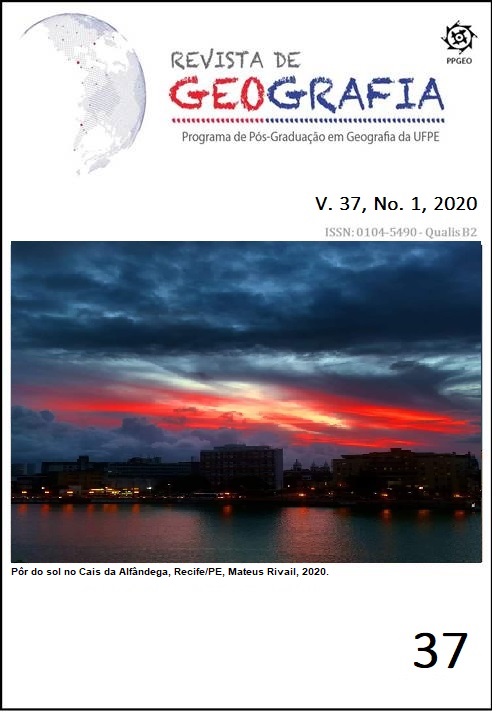Remote sensing applied for indicators of desertification in Parelhas –RN
DOI:
https://doi.org/10.51359/2238-6211.2020.239097Keywords:
NDVI; geotechnologies; vegetation cover.Abstract
IThis study aims to characterize and map the areas where there are desertification pro-cesses is more advanced in Parelhas-RN, Northwest of Brazil. For this, we collected images of the satellite Landsat -8, OLI, dated 09/29/2016 and 06/12/2017, correspond-ing to the final period, and end of the rainy season, respectively. The preprocessing pro-cedure was constructed: radiometric correction, atmospheric correctionand band fusion for the refinement of spatial resolution to 15 meters. We applied the Normalizing Differ-ence Vegetation Index -NDVI to identify the areas of greatest photosynthetic activity of the vegetation, as well as to measure the potential phytostabilizer in the environment. For the calibration of the image classification, scores of 9 control points that had differ-ent values of NDVI. We identified a desertification process advanced that allowed for vectorization and mapping. Other topics that replenished NDVI were expanding at high (> 0.21) the known to plant phytoestabiliator of the vegetation, preventing a high rate of erosion and removed the superficial layers and horizons. The methodology applied ena-bles to produce refined information on a desertification, beyond, may monitoring and generate subsidies for environmental recovery.ncluir o abstract
References
AB'SABER, A. N. Depressões periféricas e depressões semiáridas no Nordeste do Brasil. Boletim de Geografia. Seção Regional de São Paulo, (22): 3-18, 1956.
AB'SABER, A. N. Participação das superfícies aplainadas nas paisagens do Nordeste brasileiro. Geomorfologia,São Paulo, (19) 1-38, 1969.
ALMEIDA, F.F.M., LEONARDOS, O. H. VALENÇA, J. Review on granitic rocks of Northeast South America. In. Symposium on northeast south america granites, recife, iugs/unesco, 1967.
ALVARENGA, A. S; MORAES, M. F. Utilização de imagens LANDSAT –8 para caracterização da cobertura vegetal. Mundogeo. Junho de 2014. Disponível em: http://mundogeo.com/blog/2014/06/10/processamento-digital-de-imagens-landsat-8-para-obtencao-dos-indices-de-vegetacao-ndvi-e-savi-visando-a-caracterizacao-da-cobertura-vegetal. Acesso em: 25 jun 2018.
AMORIM, I. L. B.; Sampaio, E. V. S.; Araújo, E. L. Flora e estrutura da vegetação arbustivo-arbórea de uma área de caatinga do Seridó, RN, Brasil. Acta Botânica Brasílica, 19 (3), 615-623, 2005.
ANDRADE, L.A. de. Impactos da invasão de Prosopis juliflora (sw.) DC. (Fabaceae) sobre o estrato arbustivo-arbóreo em áreas de Caatinga no Estado da Paraíba, Brasil. in Acta Scientiarum. Biological Sciences-Maringá, 32 (3) 249-255, 2010.
Downloads
Published
How to Cite
Issue
Section
License
Copyright (c) 2021 Paulo Igor de Melo Albuquerque, João Paulo Bezerra Rodrigues, Filipe da Silva Peixoto, Mateus de Paula Miranda

This work is licensed under a Creative Commons Attribution 4.0 International License.
Autores que publicam nesta revista concordam com os seguintes termos:
a) Autores mantêm os direitos autorais e concedem à REVISTA DE GEOGRAFIA da Universidade Federal de Pernambuco o direito de primeira publicação, com o trabalho simultaneamente licenciado sob a Licença Creative Commons Atribuição 4.0 Internacional. CC BY -  . Esta licença permite que os reutilizadores distribuam, remixem, adaptem e criem a partir do material em qualquer meio ou formato, desde que a atribuição seja dada ao criador. A licença permite o uso comercial.
. Esta licença permite que os reutilizadores distribuam, remixem, adaptem e criem a partir do material em qualquer meio ou formato, desde que a atribuição seja dada ao criador. A licença permite o uso comercial.
b) Autores têm autorização para assumir contratos adicionais separadamente, para distribuição não-exclusiva da versão do trabalho publicada nesta revista (ex.: publicar em repositório institucional ou como capítulo de livro), com reconhecimento de autoria e publicação inicial nesta revista.
c) Autores têm permissão e são estimulados a publicar e distribuir seu trabalho online (ex.: em repositórios institucionais ou na sua página pessoal) a qualquer ponto antes ou durante o processo editorial, já que isso pode gerar alterações produtivas, bem como aumentar o impacto e a citação do trabalho publicado.
d) Os conteúdos da REVISTA DE GEOGRAFIA estão licenciados com uma Licença Creative Commons Atribuição 4.0 Internacional. CC BY -  . Esta licença permite que os reutilizadores distribuam, remixem, adaptem e criem a partir do material em qualquer meio ou formato, desde que a atribuição seja dada ao criador. A licença permite o uso comercial.
. Esta licença permite que os reutilizadores distribuam, remixem, adaptem e criem a partir do material em qualquer meio ou formato, desde que a atribuição seja dada ao criador. A licença permite o uso comercial.
No caso de material com direitos autorais a ser reproduzido no manuscrito, a atribuição integral deve ser informada no texto; um documento comprobatório de autorização deve ser enviado para a Comissão Editorial como documento suplementar. É da responsabilidade dos autores, não da REVISTA DE GEOGRAFIA ou dos editores ou revisores, informar, no artigo, a autoria de textos, dados, figuras, imagens e/ou mapas publicados anteriormente em outro lugar.


